Editor’s Note: We are looking up as HMNS Astronomer James Wooten explains the sky happenings for the month of June and the upcoming Summer Solstice.
Venus remains high in the evening sky this month. It is high in the west at dusk each evening.
Mars is now high in the west at dusk. As Earth continues to pull away from Mars, Mars is a little dimmer each evening. Watch Venus approach Mars each evening.
Saturn is in the morning sky this month; face south southeast just before dawn.
Jupiter is in the morning sky this month. Look in the east as day breaks.

Spring stars are high in the south and west. A distinct backwards question mark shape outlines the mane and forepaws of Leo, the Lion. Three stars forming a right triangle are to its upper left; they mark Leo’s hindquarters. The Big Dipper is as high as it ever gets in the north at dusk. You can extend the curve of its handle to ‘arc to Arcturus’ and then ‘speed on to Spica’. These stars high in the east and south, respectively, by dusk tonight. Arcturus, by the way, is the fourth brightest star we ever see at night, but the brightest one Americans ever see in all of June and July.
In the east, look for the enormous Summer Triangle, consisting of the stars Deneb, Vega, and Altair. This triangle is up all night long in June and July, hence its name. Scorpius, the Scorpion, is in the southeast at dusk. Sagittarius, the Archer, known for its ‘teapot’ asterism, rises just after dusk on June 1, but is up by nightfall on June 30.
Moon Phases in June 2023
Full June 3, 10:42 p.m.
Last Quarter June 10, 2:31 p.m.
New June 17, 11:37 p.m.
1st Quarter June 26, 2:50 a.m.

At 9:58 am on Wednesday, June 21, the Sun is directly overhead as seen from the Tropic of Cancer. This means that Earth’s north pole is tilted as much as possible towards the Sun, making this our summer solstice. On this date the midday Sun is as high as possible in our sky—virtually overhead—and we have more daylight than on any other day of the year. Below the equator, the opposite is true. There, the midday Sun is as low as possible in the sky, and there is less daylight than on any other day of the year. For them, June 20 is the winter solstice.
Our George Observatory is now open every Saturday night for observing! Purchase tickets in advance on our website.
Clear Skies!
Missed last month’s sky happenings? Check it out here.






